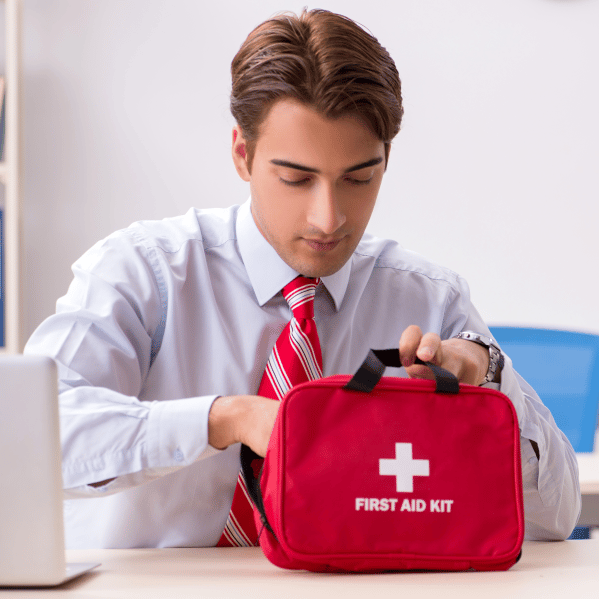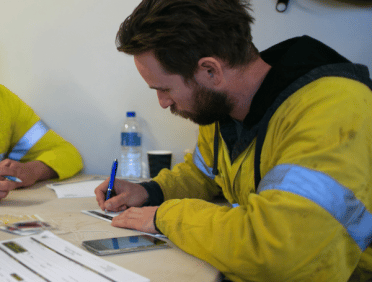Filter by
Emergency First Aid Course
An emergency first aid course is indispensable for individuals who wish to secure themselves against unforeseen medical emergencies. Whether it is a trivial injury or a critical incident, the ability to provide immediate assistance can have a substantial impact.
These courses are intended to provide individuals with the skills necessary to effectively manage emergencies, thereby ensuring the protection and well-being of those in their vicinity.
Enrolling in an emergency first aid course in the United Kingdom is a proactive measure that can help ensure safety in daily life. The skills you have acquired not only equip you to manage emergencies, but they also contribute to the welfare of your community.
In critical moments, you can make a significant impact by remaining informed and trained and offering comfort and care when it is most required.
The importance of first aid training
The importance of first aid training is that it enables individuals to respond to emergencies with confidence and competence. You can mitigate the severity of injuries and potentially save lives by comprehending the rapid assessment of situations and the provision of the necessary care.
For instance, the likelihood of survival can be increased by twofold or even triple when one is capable of administering cardiopulmonary resuscitation (CPR) to an individual who is experiencing cardiac arrest.
The capacity to manage common injuries, including burns, cuts, and fractures, facilitates a quicker recovery and reduces long-term damage.
Course Content and Structure
Emergency first aid courses in the UK typically cover a range of topics to provide a comprehensive foundation.
These include:
Basic Life Support (BLS)
This section addresses critical competencies, including the use of an Automated External Defibrillator (AED), CPR, and the management of choking incidents. The most recent resuscitation techniques and the significance of opportune intervention are imparted to participants.
These life-saving skills can be practiced during practical sessions, which guarantees that learners are adequately equipped to respond to real-world scenarios.
Wound Care
Participants acquire the ability to manage haemorrhaging, prevent infections, and treat a variety of wounds. This encompasses comprehending various forms of wounds, including punctures, lacerations, and abrasions.
The risk of complications is mitigated by the effective management of wounds, which is achieved through the application of antiseptics, proper cleansing, and dressing techniques.
Management of Common Injuries
This encompasses the management of injuries, fractures, sprains, and strains. The instructor instructs the participants to evaluate the severity of injuries and implement the appropriate first aid measures. The treatment of burns may involve the application of a sterile dressing and the chilling of the affected area.
When a fracture occurs, immobilisation techniques are used to stop further damage until medical help arrives.
Recognising and Responding to Medical Conditions
The course also instructs students on how to recognise and respond to conditions such as asthma attacks, strokes, and heart attacks. It is imperative to identify early signs and symptoms in order to promptly intervene.
For example, the identification of stroke symptoms (FAST: face drooping, arm weakness, speech difficulties, time to notify emergency services) can result in improved outcomes and a faster treatment process.
Similarly, the ability to provide support to an individual who is experiencing an asthma attack or allergic reaction can prevent the situation from escalating to a life-threatening level.
Legal aspects and first aid kit management
We also address the legal obligations associated with administering first aid and the necessity of maintaining a well-stocked first aid kit. Participants are educated on the significance of consent and their legal obligations when administering first aid.
The course underscores the necessity of conducting routine inspections and replenishments of first aid cases to guarantee that all essential supplies are present and in good condition. This comprises the following: antiseptics, bandages, and personal protective equipment (PPE).
Hands-On Training
Hands-on practice is a critical element of first aid instruction. Participants participate in practical sessions that allow them to apply techniques to manikins and role-play scenarios. This practical experience is invaluable in that it contributes to the development of muscle memory and confidence.
In a real-life scenario, for instance, the repetition of CPR training guarantees that your response is both effective and rapid. These sessions frequently incorporate instructor guidance and peer feedback, which contribute to improved retention and learning.
Certification and Renewal
A certification that is typically applicable for three years is awarded to participants upon successful completion of the course. Not only does this certification serve as an endorsement of your abilities, but it is also mandatory in numerous job environments. It is advised that you periodically enrol in refresher courses to guarantee that your knowledge and abilities remain up-to-date.
Updates on new first aid protocols and advanced techniques are frequently included in the renewal process, guaranteeing that you are consistently equipped to deliver the highest quality of treatment.
Benefits of First Aid Training in the Workplace
First aid training in the workplace provides a multitude of advantages. By ensuring that employees are equipped to manage emergencies, it cultivates a secure work environment. This preparedness can mitigate the severity of workplace injuries and ailments, resulting in minimal lost workdays and reduced healthcare expenses.
Giving staff members the reassurance that their colleagues are ready to help in an emergency helps to improve team cohesion. The significance of first aid training is underscored by the fact that it is a legal requirement in certain sectors, such as construction or manufacturing.
Frequently Asked Questions (FAQs)
The Emergency First Aid at Work (EFAW) course is a fundamental training program that is intended to provide individuals with the necessary skills and knowledge to manage emergency first aid situations in the workplace. All workers in businesses, regardless of size, who are assigned as first responders must finish the course.
The program guarantees that participants can respond promptly and effectively to a variety of medical emergencies, thereby improving the safety of the workplace.
EFAW training is the preferred course of action for businesses in a variety of sectors, particularly those in which the work environment poses a risk of injury or illness. Employees in positions such as office staff, retail workers, and those in light manufacturing frequently enrol in this course to satisfy their employer’s health and safety standards.
The Health and Safety (First Aid) Regulations 1981 require employers to provide sufficient and suitable first aid apparatus, facilities, and personnel to guarantee that their employees receive immediate attention in the event of an injury or illness at work.
Individuals who are accountable for lone workers or those in remote locations should also participate in EFAW to guarantee comprehensive emergency coverage. Businesses can satisfy their legal obligations and establish a secure work environment by training their personnel in EFAW.
The Health and Safety (First Aid) Regulations 1981 mandate that UK workplaces provide sufficient first aid as a matter of law. These regulations require employers to provide personnel, facilities, and equipment that are suitable and sufficient to ensure that their employees receive immediate medical attention in the event of an injury or illness at work.
The specific requirements may differ based on the nature of the task and the workplace environment.
Employers must conduct a first aid requirements assessment to ascertain the necessary level of first aid provision. This evaluation should take into account the location of the workplace, the character of the work being performed, and the size of the workforce.
Employers are required to guarantee that there is an adequate quantity of trained first aiders, suitable first aid equipment, and easily accessible first aid facilities, as determined by this evaluation.
Employers are required to maintain first aid equipment and facilities in a functional state, as well as to ensure that first aiders receive regular renewal training, in addition to providing training for them. This guarantees that the first aid provision remains legal and effective.
The Emergency First Aid at Work (EFAW) certification is applicable for a period of three years. First aiders are required to complete a requalification course to maintain their certification and guarantee that their skills and knowledge are current after this period.
This requalification is imperative for the purpose of ensuring the effectiveness of first aid provision in the workplace and for compliance with legal requirements.
First aiders are advised to participate in annual refresher training to maintain their proficiency during the three-year validity period. Shorter, half-day sessions that review the fundamental principles and practices of emergency first aid can be implemented to accomplish this.
Regular training is instrumental in ensuring that first aiders maintain their confidence in their capacity to manage emergencies.
Employers should monitor the expiration dates of their first aiders’ certifications and organise requalification training in advance. This proactive approach guarantees ongoing adherence to health and safety regulations and prevents any breaches in first aid coverage.
The depth and scope of the training provided constitute the primary distinctions between Emergency First Aid at Work (EFAW) and First Aid at Work (FAW) courses. EFAW is a one-day course that is intended to provide a comprehensive understanding of the fundamentals of first aid in emergency situations.
It is suitable for jobs with little risk. In contrast, FAW is a three-day course that is more comprehensive and is appropriate for higher-risk workplaces. It covers a broader spectrum of first aid scenarios.
EFAW emphasises the acquisition of basic first aid skills, including the administration of cardiopulmonary resuscitation (CPR), the management of minor injuries, and the identification and treatment of common medical emergencies, including haemorrhaging and choking.
This program provides participants with the necessary skills to provide immediate assistance until professional medical assistance is available.
FAW encompasses all the subjects addressed in EFAW, as well as additional topics, including the management of severe injuries, the conduct of secondary assessments, and the management of a broader spectrum of medical conditions.
This course also includes practical assessments to guarantee that participants can effectively implement their skills in real-world situations.
Employers should determine the appropriate course by conducting a first aid needs assessment and taking into account the unique hazards and requirements of their workplace.
The comprehensive FAW training would be more advantageous in high-risk environments, such as factories or construction sites.
Practical skills necessitate hands-on practice and evaluation during Emergency First Aid at Work (EFAW) training. Consequently, it is not feasible to execute it entirely online. Although some theoretical components of first aid can be taught through online learning modules, the practical aspects require in-person training.
The practical sessions of EFAW encompass the treatment of wounds and injuries, the implementation of automated external defibrillators (AEDs), and hands-on practice of cardiopulmonary resuscitation (CPR). A qualified instructor must demonstrate and evaluate these skills to guarantee that participants are capable of conducting them.
Blended learning options are available from certain providers, which involve the development of theoretical knowledge online and a subsequent practical session in person. This method integrates the practicality of hands-on training with the convenience of online learning.
Employers must guarantee that the EFAW training they offer adheres to the standards established by the Health and Safety Executive (HSE) in the United Kingdom, which necessitates the inclusion of practical assessments.
The Emergency First Aid at Work (EFAW) course is a comprehensive course that is intended to provide participants with the necessary skills to manage common workplace emergencies. It covers a variety of essential topics.
The course typically commences with an overview of the duties and responsibilities of a first aider, as well as the principles of first aid. This fundamental knowledge is essential for comprehending the significance of immediate action and the extent of first aid.
Key topics include:
- Cardiopulmonary Resuscitation (CPR) and Automated External Defibrillator (AED) Use: Participants learn how to perform CPR and use an AED, critical skills for responding to cardiac arrest situations.
- Managing Unconscious Casualties: This section covers the recovery position and how to assess and monitor an unconscious person.
- Choking: Participants are taught the techniques for relieving choking in both adults and children, including back blows and abdominal thrusts.
- Wounds and bleeding: This topic includes the management of minor and major bleeding and how to use dressings and bandages effectively.
- Shock: Understanding the causes and symptoms of shock and how to provide appropriate first aid care.
The course may also address additional pertinent subjects, including the management of convulsions, the treatment of burns, and the management of minor injuries such as sprains and strains. Practical assessments guarantee that participants can confidently implement their knowledge in real-world scenarios.
If a medical emergency occurs at work, it is important to remain composed and act promptly. Before approaching the casualty, evaluate the situation to determine whether it is secure for you to do so. Look for any imminent hazards, such as electrical hazards or traffic, and ensure that the area is safe to the extent possible.
Next, assess the casualty’s responsiveness by gently shaking them and calling for a response. Call 999 promptly and request an ambulance if the individual is not breathing normally and there is no response.
Provide clear and concise information regarding the location and nature of the emergency. If you have received training and an AED is accessible, initiate CPR; adhere to the device’s instructions.
Assess the casualty’s condition and offer reassurance if they are responsive. Follow the training you received during your EFAW course to administer first aid as needed. This may entail the treatment of wounds, the management of trauma, or the provision of care for specific conditions, such as seizures or choking.
Ensure that a person remains with the casualty until professional medical assistance arrives. If feasible, have another individual assist the emergency services in reaching your location. Document all actions taken and any observations regarding the casualty’s condition, as this information will be beneficial to the medical responders.
First aiders must renew their Emergency First Aid at Work (EFAW) training every three years to guarantee that they are proficient in the most recent first aid techniques. The Health and Safety (First Aid) Regulations 1981 mandate the three-year requalification, which is essential for the preservation of high-quality first aid services in the workplace.
First aiders are advised to attend annual refresher courses during the three-year period. The shortened sessions serve to reinforce essential skills and knowledge, thereby ensuring that first aiders maintain their confidence in their ability to respond to emergencies.
Employers are advised to monitor the expiration dates of their employees’ certifications and arrange for requalification training in advance. This proactive approach protects against any gaps in first aid coverage and guarantees continuous adherence to legal obligations.
The renewal of EFAW certification not only fulfils legal obligations but also promotes a secure work environment by guaranteeing that trained first aiders are consistently accessible to address emergencies.
Several critical responsibilities are incumbent upon a first aider in the workplace to guarantee the health and safety of their colleagues. The primary function is to administer immediate and effective first aid to any individual who is injured or unwell at work.
Administering appropriate first aid treatment, conducting an assessment of the situation, and obtaining additional medical assistance as required are all components of this process.
Through consistent training and requalification courses, first aiders are required to continue to develop their knowledge and abilities. In addition to being acquainted with the workplace’s first aid procedures, they should be aware of the locations of first aid equipment and facilities.
Their responsibilities also include guaranteeing that first aid supplies are readily available and adequately stocked.
First aiders are accountable for documenting the specifics of incidents in the workplace’s accident journal or first aid log, in addition to administering first aid. This documentation is crucial for legal compliance and can offer valuable insights to prevent future incidents.
First aiders are also responsible for serving as a point of contact for health and safety concerns, fostering a secure work environment, and motivating others to comply with safety protocols. In the workplace, they are essential to the overall health and safety strategy.
Completion of particular qualifications and training programs is required to become a certified Emergency First Aid trainer. To begin, it is imperative that you possess a current and valid First Aid at Work (FAW) certificate, as this serves as evidence of your thorough comprehension of first aid procedures.
Next, you will be required to complete a teaching or training qualification, such as the Level 3 Award in Education and Training (AET). This certification offers the requisite expertise and information to conduct training sessions that are both efficient and effective.
Certain training providers may provide courses that encompass both teaching qualifications and first aid.
You are required to complete a specific course for first aid trainers, such as the First Aid Trainer/Assessor course. This specialised training provides you with the ability to impart first aid courses, evaluate the proficiency of learners, and guarantee the quality of training delivery.
Upon obtaining these qualifications, you may submit an application to become an approved trainer with a reputable first aid training organisation. This approval process may entail the demonstration of your teaching abilities and first aid knowledge through assessments or observations.
Staying informed about the most recent first aid practices and regulations is crucial for maintaining your certification. Continuing professional development is essential. You will be able to remain effective and current as a first aid trainer by regularly attending industry events, refresher courses, and seminars.
The minimum number of first aiders necessary in a workplace is contingent upon the specific requirements and risks associated with the workplace environment. Employers are required to conduct a first aid requirements assessment in order to ascertain the appropriate level of first aid provision, as per the Health and Safety (First Aid) Regulations 1981.
A minimum of one designated individual should be present to oversee first aid provisions in low-risk workplaces, such as offices and shops. One first aider who has been trained in Emergency First Aid at Work (EFAW) may be adequate if the workplace has fewer than 25 employees.
It is advisable for workplaces with 25–50 employees to have at least one first aider who has been trained in EFAW.
The requirements are more stringent in higher-risk environments, such as manufacturing plants or construction sites. For instance, First Aid at Work (FAW) certification is mandatory for at least one first aider in a higher-risk environment with 5–50 employees.
First aiders may be necessary in workplaces with more than 50 employees, with the precise number of personnel determined by the first aid requirements assessment.
Employers must guarantee that there are sufficient first aiders to cover all schedules and locations within the workplace. The first aid requirements assessment must be reviewed on a regular basis to account for changes in the size of the workforce or the conditions of the workplace.
Enrolling in an Emergency First Aid at Work (EFAW) course does not require any specific qualifications. The course is intended to be accessible to a diverse group of participants, irrespective of their prior experience or background in first aid. Nevertheless, there are a few factors to bear in mind.
Participants must possess a fundamental comprehension of the English language, as the course content is presented in this language and necessitates the reading and comprehension of written materials, as well as the completion of practical assessments.
It is also advantageous to be in good physical condition, as the course involves practical application of first aid techniques, including the movement of casualties and the performance of cardiopulmonary resuscitation (CPR).
Although no prior knowledge of first aid is necessary, it is imperative to demonstrate a commitment to learn and actively engage in both the theoretical and practical aspects of the course. Employers may choose individuals who exhibit a propensity for acquiring new skills and who can maintain composure in high-pressure situations to participate in the training.
Certain training providers may provide participants with preparatory materials or preliminary assessments to assist them in preparing for the course. This can be particularly beneficial for individuals who may experience anxiety regarding their capacity to conduct first aid tasks.
A comprehensive first aid requirements assessment and the implementation of appropriate measures based on the results are effective strategies for businesses to ensure compliance with UK first aid regulations. Consideration should be given to the nature of the work being performed, the number of employees, and the specific hazards associated with the workplace in this assessment.
Businesses should ensure that designated first aiders receive sufficient first aid training after the assessment is finalised. Depending on the identified level of risk, this may involve enrolling employees in certified courses such as First Aid at Work (FAW) or Emergency First Aid at Work (EFAW).
Ensuring that first aiders’ certifications are up-to-date and arranging for requalification as necessary is essential for maintaining ongoing compliance.
Businesses must also guarantee that first aid equipment and facilities are accessible and well-maintained. This entails the provision of appropriately stocked first aid kits and the guarantee that they are readily accessible to all employees. It is recommended that supplies be replenished and expired products be replaced on a regular basis.
Companies should create explicit first aid rules and practices, let every staff member know about them, and schedule frequent exercises to make sure everyone responds in an emergency. Crucial for proving regulatory compliance and for ongoing development are thorough records of training, mishaps, and first aid policies.
If someone is unresponsive and not breathing, immediate action is critical to increase their chances of survival. The following steps should be taken:
Ensure Safety
Quickly check the area for any dangers to yourself or the casualty. Make the environment safe before proceeding.
Check Responsiveness
Gently shake the person and shout to see if they respond. If there is no response, proceed to the next step.
Call for Help
Dial 999 immediately and request an ambulance. Provide clear information about the location and nature of the emergency.
Begin CPR
Start chest compressions if the person is not breathing normally or at all. Interlock your fingers after one hand’s heel finds the middle of their chest and the other hand is placed on top. Press down rapidly and forcefully, 100– 120 compressions per minute. Between compressions, let the chest totally collapse.
Use an AED
Turn on and follow the directions of an automated external defibrillator (AED) if one is available. As the diagrams on the pads illustrate, fasten the pads to the person’s chest. The AED will examine the heart rhythm and provide recommendations regarding the requirement of a shock. Press the shock button and make sure nobody is touching the victim if advised a shock.
Continue CPR
Until emergency medical personnel come, the victim exhibits signs of life, or you are too tired to keep going, keep administering CPR. If others are available, alternate doing CPR to prevent tiredness.
Maintaining blood flow to the person’s key organs and raising the possibility of a favourable outcome depend on these actions, so professional support becomes even more important.
While the primary objective of emergency first aid training is to provide immediate care during medical emergencies, it can also indirectly contribute to the reduction of workplace accidents.
Trained first aiders are more cognisant of the significance of maintaining a safe work environment and potential hazards. This awareness can result in proactive measures that prevent accidents from occurring.
First aid training fosters a safety-conscious attitude in employees, motivating them to promptly report and identify hazards, adhere to safety protocols, and properly utilise personal protective equipment. The presence of trained first aiders can also foster a culture of safety in which employees feel more confident and supported in their endeavour to maintain a safe workplace.
First aid training frequently encompasses instruction on accident prevention and risk assessment. Employees can reduce the likelihood of workplace injuries and ailments by comprehending the most prevalent causes. In high-risk environments, this knowledge can be especially beneficial, as preventive measures can substantially decrease the probability of accidents.
Although the primary objective of emergency first aid training is to deliver immediate care, the program’s broader implications include the promotion of a safer work environment and the mitigation of workplace incidents by means of enhanced awareness and proactive safety measures.
A first aid kit that is well-stocked with essential items is necessary to address a wide range of medical emergencies that may occur in the workplace. The specific contents may differ based on the workplace environment and identified hazards; however, certain essential items should always be included.
- Adhesive Bandages and Dressings: Various sizes of adhesive bandages for minor cuts and abrasions and sterile dressings for larger wounds.
- Sterile Gauze Pads and Tape: For covering and protecting wounds, controlling bleeding, and securing dressings in place.
- Antiseptic wipes: for cleaning wounds and reducing the risk of infection.
- Disposable gloves: To protect both the first aider and the casualty from cross-contamination.
- CPR Face Shield or Pocket Mask: To provide a barrier during mouth-to-mouth resuscitation.
- Scissors and tweezers: for cutting dressings, tape, and clothing, and for removing foreign objects from wounds.
- Instant Cold Packs: To reduce swelling and pain from injuries such as sprains or fractures.
- Eye Wash Solution: To rinse out contaminants or irritants from the eyes.
- Triangular Bandages: For use as slings to support injured limbs or as improvised dressings.
- First Aid Manual: A guide to basic first aid procedures and emergency care.
Regular inspections should be implemented to guarantee that all items are present, in excellent condition, and within their respective expiration dates. Other critical factors include tailoring the first aid kit to mitigate particular hazards in the workplace and guaranteeing that it is easily accessible to employees.
There are several critical measures to take in order to ensure that you receive high-quality and accredited emergency first aid training from a reputable provider. Start by conducting research on providers that have been approved by reputable organisations, such as the Health and Safety Executive (HSE) or the First Aid Industry Body (FAIB).
These entities establish comprehensive standards for first aid training and guarantee that providers satisfy stringent requirements.
Search for providers that provide courses that are accredited by recognised organisations, such as the Scottish Qualifications Authority (SQA) or Ofqual. Employers and regulatory bodies accredit courses to guarantee that the training content and delivery adhere to national standards.
Check the provider’s reputation and the quality of their training by reading reviews and testimonials from previous participants. Confidence in the provider’s capacity to provide engaging and effective training can be reinforced by positive feedback from others.
Evaluate the qualifications and experience of the provider. Instructors must possess certification and pertinent experience in both teaching and first aid. Verify whether the provider provides versatile training options, such as on-site training for businesses, which can be more convenient and customised to your specific requirements.
Compare the prices and course offerings to guarantee that you receive a satisfactory return on your investment. Although cost is a critical consideration, it is crucial to prioritise quality and accreditation to guarantee that the training you receive is both effective and in accordance with legal mandates.
There are numerous prevalent misconceptions regarding emergency first aid that may result in inadequate preparedness and misunderstandings. A prevalent misconception is that first aid training is exclusively required for high-risk occupations.
In reality, first aid emergencies can occur at any location, and it is essential for all types of workplaces, including low-risk environments such as offices and retail stores, to have trained first aiders.
Yet another misconception is that individuals are not required to maintain their proficiency in first aid after they have received training. Nevertheless, it is imperative to undergo regular refresher training to maintain proficiency and assure preparedness for emergencies, as first aid techniques and guidelines are subject to change.
Some individuals are of the opinion that emergency first aid training is too complex for the average person to comprehend and implement. Although first aid training encompasses critical and potentially life-saving techniques, it is intended to be comprehensible and accessible to those without medical backgrounds.
The training concentrates on the acquisition and application of practical skills that are readily masterable by anyone.
Misconception: First aiders may be subject to legal liability if they administer assistance inaccurately. The Social Action, Responsibility, and Heroism Act 2015 in the United Kingdom offers legal protection to individuals who act with good intentions and responsibly in order to assist others during emergencies.
This safeguard incentivises individuals to act without concern for legal consequences.
First aid training can be customised to address specific workplace hazards by conducting a comprehensive risk assessment and identifying the specific risks associated with the work environment.
This assessment will assist in identifying the most probable types of injuries or medical emergencies and will serve as guidance for the customisation of the training content.
For instance, in a manufacturing environment that is susceptible to cuts and crush injuries, the training may prioritise wound management, haemorrhage control, and fracture management.
In an office setting where ergonomic concerns and tension are prevalent, the training may concentrate on the identification and management of musculoskeletal injuries and stress-related incidents.
Scenario-based exercises that simulate potential workplace emergencies may also be incorporated into customised training. In addition to fostering confidence in their capacity to respond effectively, these practical exercises also provide participants with the opportunity to practice their skills in realistic situations.
Engaging employees in the customisation process can offer them valuable insights into the specific challenges and hazards they encounter. This collaborative approach guarantees that the training is pertinent and meets the actual requirements of the workforce.
Employers can guarantee a more effective response to emergencies by ensuring that their employees are prepared and safe by aligning first aid training with the unique risks of the workplace.
A report on an incident involving first aid should contain information that is both factual and informative regarding the incident in order to guarantee proper documentation and follow-up.
Key elements to include are:
- Date and Time of the Incident: Record the exact date and time when the incident occurred.
- Location of the Incident: Specify the precise location within the workplace where the incident took place.
- Details of the Injured Person: Include the name, job title, and contact information of the injured person.
- Description of the Incident: Provide a clear and concise description of what happened, including the sequence of events leading up to the incident.
- Nature of the Injury or Illness: describe the type and extent of the injury or illness sustained.
- First Aid Provided: Detail the first aid treatment administered, including any equipment used and the names of the first aiders involved.
- Follow-Up Actions: Note any further actions taken, such as calling emergency services, referring the injured person to a medical professional, or notifying management.
- Witness Statements: Include statements from any witnesses to the incident, if applicable.
- Signature of the First Aider: The report should be signed by the first aider who provided treatment to confirm the accuracy of the information.
The maintenance of detailed first aid event reports helps with legal compliance, assists in the identification of patterns or hazards that occur repeatedly, and promotes the ongoing improvement of workplace safety standards.




















